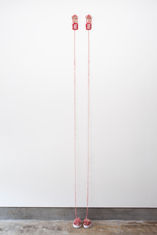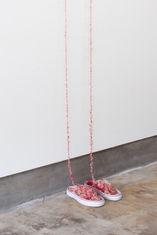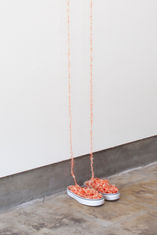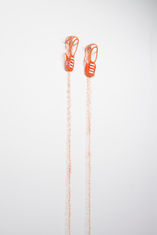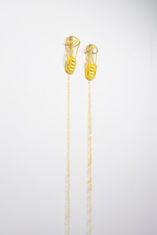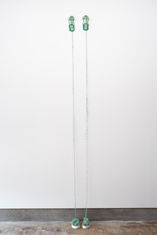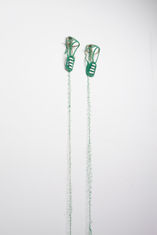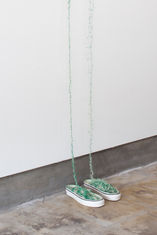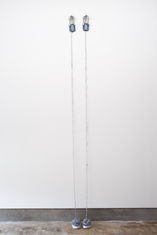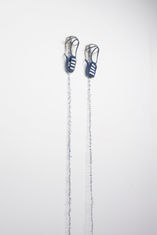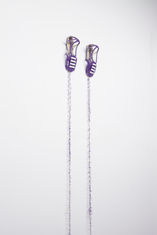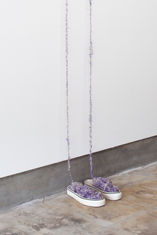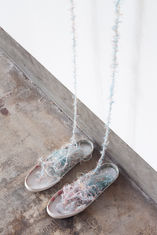Artists & available artworks
Kaoru Hirano 平野薫
Ruriko Miyamoto 宮本ルリ子
Mineo Mizuno 水野峰夫
Daigoro Yonekura 米倉大五郎
Ayaka Umeda 梅田綾香
Chisato Kobayakawa 小早川智里
Our sales are available on Artsy.
Please visit their website for more details.
これらの作品はArtsyで販売してます。
詳細はどうかこちらをご覧ください。
View the list of artworks on Artsy: 作品一覧を見る
Kaoru Hirano 平野薫
a recipient of the 2025 Gottlieb Foundation Individual Support Grant
series of spectrum (2021)
Kaoru Hirano
rainbow_VANS red #1
(2021)
VANS sneaker
dimensions variable
30(w) x 272(h)cm
$ 3000
Kaoru Hirano
rainbow_VANS orange#1
(2021)
VANS sneaker
dimensions variable
30(w) x 272(h)cm
$3000
Kaoru Hirano
rainbow_VANS yellow#1
(2021)
VANS sneaker
dimensions variable
30(w) x 272(h)cm
$3000
Kaoru Hirano
rainbow_VANS green #1
(2021)
VANS sneaker
dimensions variable
30(w) x 272(h)cm
$3000
Kaoru Hirano
rainbow_VANS blue#1
(2021)
VANS sneaker
dimensions variable
30(w) x 272(h)cm
$3000
Kaoru Hirano
rainbow_VANS violet#1
(2021)
VANS sneaker
dimensions variable
30(w) x 272(h)cm
$3000
Kaoru Hirano
untitled_VANS
stars & stripes
(2024)
VANS sneaker
dimensions variable
30(w) x 272(h) cm
$3000
Please contact gallery
Kaoru Hirano’s sculptural textile practice centers on the signs and histories embedded in cloth. She reconstructs old clothes, umbrellas, and other materials by unraveling them thread by thread, reflecting on the relationships between memory and history.
In recent years, she has worked with the Japanese national flag, “Hinomaru,” to explore the social and historical meanings embedded in everyday fabrics.
In her deconstructed shoe works, Hirano investigates the material traces of the body. By carefully disassembling worn shoes and reconfiguring them into new sculptural forms, she gives presence to the invisible—gesture, memory, and movement—contained within these utilitarian objects.
Her process embodies both fragility and persistence, capturing moments of transformation through the labor of the hand.
This series of works was created during the 2021 Artist-in-Residence program. For more details, please click here. more info

Kaoru Hirano
rope-hinomaru-
(2023)
Japanese flag
75(h) x 7(w) x 7(d)cm
65(h) x 7(w) x 7(d)cm
$1600
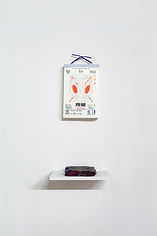%E3%81%AE%E3%82%B3%E3%83%94%E3%83%BC_edited.jpg)
Kaoru Hirano
2024
(2023)
Calendar
18(h)x8(w)x6(d)inch
40(h)x20(w)x15(d)cm
installation size
$800
Kaoru_Hirano1%E3%81%AE%E3%82%B3%E3%83%94%E3%83%BC.jpeg)
Kaoru Hirano
untitled
(2023)
boxer shorts
18(h)x6(w)x3.2(d)inch
45(h)x15(w)x8(d)cm
$3000
untitled (2023)
Untitled (2023) is a textile work created from old garments, unraveled and reconstructed thread by thread. Influenced by Louise Bourgeois’s iconic sculpture Fillette (1968), Hirano approaches the form as a process of decoding—dismantling an everyday garment and reconfiguring it into a fragile yet charged presence. The work suggests both vulnerability and resilience, leaving a form suspended between memory and imagination.
Ruriko Miyamoto 宮本ルリ子



Ruriko Miyamoto
Stack #3: Series of Eternal:Evanescently
(2013)
Porcelain
33.5(H) x 11.5 dia. cm
$1000
Stack #3

Stack series
Eternal・Evanescently
installation at Museum Gallery in Shigaraki Ceramic Cultural Park, Shiga (2013)
About Ruriko Miyamoto's work
Ruriko Miyamoto explores the shifting interplay between material and spirit over time through her distinctive approach to form. Her ceramic works “Eternal : Evanescently" is a theme that artist has chosen to interpret contemporary society from her unique perspective, bringing a distinctive depth to her expression. Using the modern symbol of a plastic bottle as a motif, she interweaves diverse elements inherent in ceramics to reveal the transience and fragility of human values.


Ruriko Miyamoto’s A Tale of the Touching Hands presents a series of works that explore the intersection of language, memory, and bodily sensation through tactile experience.
Building on her 2021 presentation at the National Museum of Ethnology, where she incorporated Braille under the title “The Hands from Thought to Sense, and then…”, Miyamoto continues to examine Braille’s dual role as a language system and a tactile medium directly communicating with the body.
In this exhibition, she also works with translucent Shigaraki clay, a material that gently transmits light, linking the experience of touch with that of seeing and remembering.
The works in this exhibition link Braille imagery with the form of books, becoming complete only through visitors’ touch, revealing invisible information and emotional narratives. During the exhibition, visitors’ hands were photographed and, with their consent, accompanied by comments, forming an archival ZINE that captures the living engagement between artwork and audience.
This exhibition invites visitors on a sensory journey, reflecting the poetic process by which hands feel, remember, and think.
Series: The Story of Touching Hands
The series unfolds as a poetic journey through numbers, forms, and sensations:
-
In the Beginning [1] — The origin of touch, the first encounter.
-
Each [1・1] — Individual moments, one hand at a time.
-
Sprouts [2] — New growth, new beginnings emerge.
-
Snake [3] — The flow of life, winding and responsive.
-
Waves [7・3] — Movement, rhythm, and the undulating forms of nature.
-
Waves and Wings [8・8] — Expansive energy, reaching outward like wings.
-
Waves and Leaves [8・8] — Subtle impressions of touch, traces of nature and language, Braille-like dots, and poetic resonance of “ha” and “hachi.”
-
As One — All elements converge, completing the journey; each encounter merges into a unified whole.
Through this sequence, the series explores the relationship between the body, nature, language, and touch, inviting the viewer to experience a tactile narrative where the hand becomes the storyteller.

Ruriko Miyamoto
In the beginning [ 1 ]
(2025)
Ceramic (Shigaraki Translucent clay)
7 (H) x 27 (W)x 17(D)cm
$2800
The first touch — quiet, tentative, and full of possibility.
“In the Beginning” marks the origin of the series, where contact becomes language, and the surface becomes a place of dialogue. The imprint of a hand evokes both curiosity and tenderness, suggesting that every story begins with a simple gesture of reaching out.
Through this initial encounter, the work invites viewers to rediscover touch as a form of communication — delicate, human, and profoundly alive.

Ruriko Miyamoto
Waves and Wings [ 8 ・8]
(2025)
Ceramic (Shigaraki Translucent clay)
15.5(H) x 25.5(W)x 17(D)cm
$3300
Part of the series A Tale of the Touching Hands, this piece is the seventh in the sequence, which begins with In the Beginning [1] and unfolds through Each [1・1], Sprouts [2], Snake [3], Waves [7・3], and Waves and Wings [8・8].
In Waves and Leaves, undulating pages and leaf-like impressions emerge through tactile interaction, inviting viewers to explore the connections between touch, nature, and language.
This work occupies a pivotal position in the series, illustrating the journey in which hands, materials, and sensory experience converge into a unified narrative.

Ruriko Miyamoto
As one
(2024)
Ceramic (Shigaraki Translucent clay)
12 (H) x 13.5 (W)x 17(D)cm
$2500
As the final work in the series A Tale of the Touching Hands, As Ones brings together all the elements explored throughout the journey—touch, language, nature, and the presence of the hand. The work embodies a quiet sense of unity, where traces of individual encounters merge into one harmonious whole.
Through this piece, the act of touching becomes an expression of connection and reconciliation, suggesting that every gesture, every impression, is part of a larger, shared story.

Ruriko Miyamoto
Hand [ 1 ]
(2025)
Ceramic (Shigaraki Translucent clay)
5 (H) x 18 (W)x 10(D)cm
$880
IHand
Part of the exhibition A Tale of the Touching Hands, this single porcelain hand rests quietly, as if waiting for another’s touch.
Its form suggests both offering and connection—when held, it feels like a gentle handshake, a meeting between presence and memory.
Through this simple gesture, the work reflects the essence of the exhibition: how touch can bridge distance and awaken silent emotions.
Mineo Mizuno 水野峰夫





Mineo Mizuno
Waterdrop - Zero
(pure water drop) 4
(2018)
Ceramic with Japanese Calligraphy and Glazed
4-1/4"(h) x 8" dia.
$3500
Mineo Mizuno
Waterdrop - Zero
(pure water drop) 5
(2018)
Ceramic with Japanese Calligraphy and Glazed
4"(h) x 6" dia.
$1200
Mineo Mizuno
Waterdrop - Hibiki(echo)2
(2019)
Ceramic with Japanese Calligraphy and Glazed
3-1/2"(h) x 5" dia.
$900
Mineo Mizuno
Waterdrop - Chi (wisdom)1
(2019)
Ceramic with Japanese Calligraphy and Glazed
3"(h) x 6" dia.
$1200
Mineo Mizuno
Waterdrop - Wa (harmony)
(2019)
Ceramic with Japanese Calligraphy and Glazed
4"(h) x 6-1/2" dia.
$1200




_JPG.jpg)
Mineo Mizuno
Waterdrop - Mizu (water)
(2019)
Ceramic with Japanese Calligraphy and Glazed
3-1/4"(h) x 4-1/2" dia.
$800
Mineo Mizuno
Waterdrop - Son (respect)
(2019)
Ceramic with Japanese Calligraphy and Glazed
3-1/2"(h) x 6" dia.
$1200
Mineo Mizuno
Waterdrop - Doh (passage)
(2019)
Ceramic with Japanese Calligraphy and Glazed
4-1/2”(h) x7” dia.
$1200
Mineo Mizuno
Waterdrop - Zero
(pure water drop) 6
(2018)
Ceramic with Japanese Calligraphy and Glazed
3-1/4"(h) x 5" dia.
$800
Mineo Mizuno
Waterdrop - tsunagu (connect)
(2018)
Ceramic with Japanese Calligraphy and Glazed
3-1/2"(h) x 6" dia.
$1200



Mineo Mizuno
Waterdrop - Sou (think)
(2019)
Ceramic with Japanese Calligraphy and Glazed
3"(h) x 4-1/2" dia.
Sold
Mineo Mizuno
Waterdrop - Shiki (knowledge)
(2019)
Ceramic with Japanese Calligraphy and Glazed
3-1/2"(h) x 5-3/4" dia.
Sold
Mineo Mizuno
Waterdrop - Hibiki(echo)1
(2019)
Ceramic with Japanese Calligraphy and Glazed
4"(h) x 6" dia.
$1200
Mineo Mizuno is a California-based Japanese-American artist whose work seamlessly blends elements of nature, spirituality, and Japanese aesthetics with a distinctly contemporary sensibility. Known for his organic forms and deep understanding of materials, Mizuno explores themes of harmony and tranquility, often incorporating natural elements such as water and moss into his installations. His ceramic works range from delicate, tea-inspired vessels to large-scale, meditative sculptures, each piece carrying an intentional simplicity that invites reflection. Through his art, Mizuno creates serene spaces that encourage a dialogue between viewer and nature. His current project at The Huntington Library, Art Museum, and Botanical Gardens, his installation appreciates wood in its natural state while highlighting related climate issues and ramifications.
Waterdrop Series
This ceramic piece, part of the Waterdrop series, reflects Mineo Mizuno’s deep reverence for nature and his life in the California forest. Each form bears a hand-brushed kanji character representing values such as harmony, respect, consciousness, and the essential role of water in connecting all living beings. These droplets symbolize individual human consciousness—dispersed yet deeply interconnected.
Originally placed around an upright California oak that had fallen during a harsh winter, the waterdrops evoke the presence of water in a dry landscape—small, quiet, but vital. Whether supporting sculptures of burnt oak or resting on the earth, each piece invites viewers to reflect on coexistence, interdependence, and what we can learn from nature.
These works were either featured in or created in conjunction with two major installations by Mineo Mizuno: Harmony, an outdoor installation at the Los Angeles County Museum of Art (August 2019 – February 2020), and Stories From a California Forest, a rooftop installation at Gagosian, Beverly Hills (2020).
As part of these site-specific installations rooted in a deep dialogue with nature, the Waterdrop series embodied themes of harmony, interconnection, and the essential role of water as a metaphor for consciousness and life. This particular work continues to carry the spirit and philosophy of those landmark exhibitions.

NEST – Special Edition of 5, Memory of The Huntington
NEST – Special Edition was born from a moment of reflection.
After its installation at The Huntington Library, Art Museum, and Botanical Gardens in San Marino, California, the original NEST sculpture returned to the artist’s forest studio in Northern California.
There, a real bird had quietly built a nest in a sansho (Japanese pepper) tree the artist had planted years earlier.
Nearby, birds came daily to drink from a rain chain—an installation the artist had crafted from reclaimed copper long ago.
This quiet encounter—between sculpture and nature, between intention and chance—inspired the artist to create a special edition:

Mineo Mizuno
NEST special edition (1/5) - A Single Bloom
memory of The Huntington
(2025)
Manzanita wood, Hemp twine & Ceramic
7"(h) x 13" (w) x 13" (d)
$4200
A Single Bloom is the first work in this special edition after its return to the stillness of the forest.

Mineo Mizuno
NEST special edition (4/5) - Unraveling Silence
memory of The Huntington
(2025)
Manzanita wood, Hemp twine & Ceramic
10”-1/2(h) x 15”-1/2(w)x13”(d)
$4200
Unraveling Silence is the fourth work from this special edition series NEST – memory of The Huntington.
In Unraveling Silence, the nest appears disturbed—its once-harmonious form now subtly shifting.
As if touched by time, wind, or unseen creatures, its edges loosen and begin to dissolve.
The work speaks to the fragility of silence—
how stillness, once complete, can give way to quiet disarray,
not through destruction, but through natural unraveling.
It is a meditation on impermanence, on the delicate balance between presence and absence.

Mineo Mizuno
NEST special edition (2/5) - Pair
memory of The Huntington
(2025)
Manzanita wood, Hemp twine & Ceramic
8"-1/2 (h) x 15" (w) x 13"-1/2(d)
$4200
Pair is second work from this special edition series NEST – memory of The Huntington. two delicate blooms have gently fallen into the nest.
Their placement suggests a quiet coincidence—a moment shaped not by design,
but by the subtle rhythms of nature.

Mineo Mizuno
NEST special edition (3/5) - Blooming Nest
memory of The Huntington
(2025)
Manzanita wood, Hemp twine & Ceramic
9" (h) x 16" -1/2 (w) x 12" (d)
$4200
Blooming Nest is the third work from this special edition series NEST – memory of The Huntington.
In Blooming Nest, the nest is full—overflowing with blossoms and quiet vitality.
This piece celebrates abundance and the natural cycles of life.
It speaks to the moment when nature bursts into bloom—not planned, not forced, but fully present.
A tribute to the fullness of being, and to the fragile beauty that thrives in the stillness of the forest.

Mineo Mizuno
NEST special edition (5/5) - Return To Earth
memory of The Huntington
(2025)
Manzanita wood, & Ceramic
4" (h) x 22" (w)x12”(d) dimension variable
$4200
Return to Earth captures the last quiet transformation of the original NEST sculpture.
After its three-year installation at The Huntington Library, Art Museum, and Botanical Gardens (2022–2025), the sculpture returned to Mineo Mizuno’s secluded forest studio in Northern California. There, embraced by falling leaves, shifting light, and the breath of the forest, it began to gently unravel.
Blossoms fell like forgotten memories.
Interwoven branches slowly opened, began to breathe.
What was once a singular form softened into fragments — a quiet return to origin.
Not an end, but a renewal.
This process inspired five works—each a vessel of memory and stillness.
Return to Earth is the final chapter.
Composed of 42 hand-crafted ceramic blossoms and 3 naturally curved manzanita branches, this work has no fixed form. It is meant to be arranged freely—shaped by the collector’s space, mood, and sensibility in the moment. A meditation on impermanence, dispersal, and the cyclical rhythms of nature, this piece invites introspection.
Thousand Blossoms series

Mineo Mizuno
Circle of 22 - Thousand Blossoms (2025)
Ceramic
11"(h) x 11"(w) x 2”(d)
$2200
Circle of 22 – Thousand Blossoms (Artsy Special Edition), New ceramic wall piece
Silence in bloom—twenty-two blossoms held in perfect harmony.
Created in memory of Thousand Blossoms (2020)—a tribute to lives lost during the pandemic—
Circle of 22 – Thousand Blossoms reflects on connection, unity, and quiet strength.
Each of the twenty-two blossoms represents a single life. Together, they form a continuous circle—an emblem of balance, harmony, and eternity.
Each blossom is individually hand-shaped and kiln-fired with a white glaze. The natural whiteness of the clay and the soft sheen of the glaze overlap, creating a pure and gentle presence.
Thousand Blossoms was on view at The Huntington Library, Art Museum, and Botanical Gardens from 2022 to 2025 and is now part of the museum’s permanent collection. This new work continues its spirit in a larger yet equally contemplative form—presented here as an Artsy Special Edition and available exclusively through this platform.
progress of Thousand blossoms
Within the Circle series, no two numbers are ever repeated. Each number holds its own meaning and significance, making every work entirely unique. The choice of number is as integral to the piece as the physical form itself.
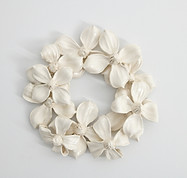
Mineo Mizuno
Circle of 11 - Thousand Blossoms (2025)
Ceramic
9"-1/2(h) x 9"-1/2(w) x 2”(d)
$1100

Mineo Mizuno
Circle of 17 - Thousand Blossoms (2025)
Ceramic
9"-1/2(h) x 9"-1/2(w) x 2”(d)
$1700

Mineo Mizuno
Circle of 9 - Thousand Blossoms (2025)
Ceramic
8"(h) x 8"(w) x 2”(d)
$900

Mineo Mizuno
Circle of 13 - Thousand Blossoms (2025)
Ceramic
9"-1/2(h) x 9"-1/2(w) x 1”3/4(d)
$1300

Mineo Mizuno
Circle of 12 - Thousand Blossoms (2025)
Ceramic
8"-3/4(h) x 8"-3/4(w) x 1”-3/4(d)
$1200

Mineo Mizuno
Circle of 19 - Thousand Blossoms (2025)
Ceramic
11"(h) x 11"(w) x 2”-1/2(d)
$1900

Mineo Mizuno
Circle of 15 - Thousand Blossoms (2025)
Ceramic
10"(h) x 10"(w) x 2”(d)
$1500

Mineo Mizuno
Circle of 16 - Thousand Blossoms (2025)
Ceramic
10"-1/2(h) x 10"-1/2(w) x 2”-1/2(d)
$1600
Daigoro Yonekura 米倉大五郎

Daigoro Yonekura
a piece of waterfall 17
(2020)
acrylic paint (W), 2k paint (B)
2k clear coat, wood panel
48(H) x 33(W) x 3(D)cm
$1400
Please contact gallery

Daigoro Yonekura
smoke and mirrors, and shade 3
(2021)
acrylic paint (W), 2k paint (B),2k clear coat, wood panel
48(H) x 33(W) x 3(D)cm
$1400
If painting comes from a black and white puddle. Then the painting would had developed into something like a lake, river or ocean. Landscape upon the lake, landscape under the lake, these are floating on the ultra-thin surface. And this thin transparent space between the landscapes is the born-place of painting. The place is swaying in the wind and reflecting the light, and is mirroring someone who peeks from there. We call now this place an image. While exploring the origin of painting and image, DaigoroYonekura's painting is developing in his own way.
Ayaka Umeda
梅田綾香
Using the traditional dyeing technique of batik, which involves creating patterns on fabric with wax and dye, Ayaka Umeda explores new possibilities in two-dimensional expression. Inspired by the perspectives of nearby nature and other living beings, the artist employs the distinctive batik process—shaped by the movements of water and its unpredictable phenomena—to bring these images to life on fabric. Through this approach, they recreate the beauty and complexity of nature in their works, crafting a unique world that is characteristic of batik.



Ayaka Umeda
Wild Grape Lights
(2023)
Batik (acid dye, silk, color fill)
18(h) x 14(w) cm each (Pair)
$1320 (price for pair, no individually sale)
Wild Grape Lights, a bird appears to dissolve into a field of golden light, suspended within a deep blue space that evokes both the cosmos and the inner world of memory. This scene is not merely symbolic—it suggests a moment of transformation, where body and light, earth and sky, nature and spirit become one. Umeda’s work invites viewers to witness the quiet magic of unity, where the seen and unseen coexist in perfect balance, like wild grapes glowing in twilight.


Ayaka Umeda
Twinkle
(2023)
Batik(acid dye, silk)
18(h) x 14(w)cm with frame 28(h) x 24(w) x 5(d) cm
$880 (price included frame )
Twinkle, a luminous, Earth-like planet floats in a vast blue cosmos—its surface adorned with dreamlike landscapes that suggest memories, myths, or imagined terrains. The flowing transitions between shapes and hues reflect the fluidity of both space and life.
Above the planet drifts a mysterious creature—part bird, part fish, perhaps even part human—gliding freely through the void.
This being, unbound by species or gravity, embodies a sense of timeless migration. It suggests the idea that life is not fixed but fluid—shaped by light, emotion, and distant echoes of nature. Twinkle becomes a quiet meditation on our place in the universe: a moment suspended between worlds, where all life-forms shimmer with shared origin, possibility, and wonder.

Ayaka Umeda
Bird Blooming in the Water
(2023)
Batik (acid dye, silk)
18(h) x 14(w) cm
$660
"Bird Blooming in the Water" unfolds within a deep, luminous blue—a space that feels both aquatic and cosmic. Created using the traditional Japanese technique of rōketsuzome (wax-resist dyeing), the piece reveals subtle textures and layered hues that flow and settle like pigment suspended in water. The technique itself mirrors the organic transitions within the composition, allowing light and color to softly interlace.
In this dreamlike scene, a bird flutters joyfully among blossoming forms that resemble water flowers—petals shaped from the very essence of fluidity and light.
The bird, neither above nor below, floats freely in a world where boundaries dissolve. Water becomes sky, flower becomes wave, and life dances in the silence between breath and memory.
Umeda gently guides us into a realm where nature is not just observed, but felt—where existence is suspended like light on water.

Ayaka Umeda
Amur Goby
(2023)
Batik (acid dye, silk)
18(h) x 14(w) cm
$660
"Amur Goby", Ayaka Umeda invites us to pause—just as the small goby fish does—on a quiet river rock beneath crystal-clear water. The goby, still and alert, gazes toward the shimmer of rippling light across the surface. In this delicate moment, the line between water and sky, between instinct and awareness, gently begins to dissolve.
The method allows her to achieve fluid transitions, glowing transparencies, and softly diffused forms that echo the natural rhythms of light and water.
That life, whether small or immense, always listens. Always waits. Always senses light.
But here, she takes it further—reminding us that living beings, no matter their form or scale, are constantly feeling the world.
They respond—silently, yet unmistakably—to the shifting of light, to the quiet changes in their surroundings.
In her vision, to live is to attune: to dwell in that hushed space where perception and presence intertwine.

Ayaka Umeda
Jade River
(2023)
Batik (acid dye, silk)
18(h) x 14(w) cm
$660
"Jade River" reveals a serene world of jade-colored waters where small fish drift gently along the riverbed. Above them, soft light shimmers on the surface, quietly reminding us of the beauty in living in harmony with nature’s flow.
As in many of Ayaka Umeda’s works, the scene evokes a sense of balance—between stillness and movement, water and light.
The fish, though modest in size, seem fully alive, breathing with the current and sensing its gentle guidance.
In a world often pulled by noise and haste, Jade River offers a return to stillness—
a reminder that the flow of time, when trusted, carries its own light.
It speaks to the quiet beauty of simply being, of sensing, and of moving forward—softly, steadily—along the river’s path.

Ayaka Umeda
Lily
(2020)
Batik (acid dye, silk)
22(h) x 27.3(w) cm
$825
"Lily" is a work used by the artist as their profile picture, depicting a blue lily flower quietly shining within a blue landscape.
The lily is a special flower to the artist, symbolizing purity, innocence, and dignity.
Created using the traditional Japanese technique of rōketsuzome (wax-resist dyeing), the artwork showcases delicate wax-resist craftsmanship, forming beautiful water-like gradients and a rich variety of blue tones.
Layers of blue hues overlap, giving the impression of a gentle fragrance emanating from the flower, with a transparency and depth that captivates the viewer.
This piece delivers a sense of calm and serene beauty, fully expressing the charm of the lily blooming in a world of blue.

Ayaka Umeda
Fascination
(2019)
Batik (acid dye, silk)
22(h) x 27.3(w) cm
$825
"Fascination" bursts with vibrant colors and joyful energy. The vivid red flower releases a spectrum of hues into the surrounding space, attracting a small bee drawn irresistibly into this lively world.
This work beautifully captures the exuberance of life and the richness of nature, inviting viewers to feel the simple pleasures and the joyful pulse of living.
Through the subtle textures and layered translucency unique to rōketsuzome, the piece radiates warmth and vitality—reminding us of the delicate yet powerful connections between all living things.

Ayaka Umeda
Garden Gems
(2023)
Batik (acid dye, silk)
22(h) x 27.3(w) cm
$825
"Garden Gems", small clusters of flowers float against a deep blue background, like fleeting memories suspended in time. These modest blossoms—easily overlooked in daily life—are elevated into quiet treasures through Umeda’s hand.
Her work invites us to notice the gentle presence of nature’s offerings, capturing the moment when the ephemeral becomes eternal, and the ordinary transforms into something luminous.

Ayaka Umeda
Spring Wild Plants
(2021)
Batik (acid dye, silk)
31.8(h) x 41(w) cm
$1848
"Spring Wild Plants", she captures the quiet yet resilient presence of early seasonal flora. Through her eyes, these wild plants are not merely decorative motifs, but bearers of memory and time—emerging each spring as quiet witnesses to the land’s enduring rhythms. Her work reflects a worldview where the subtle, overlooked details of nature hold profound meaning.

Ayaka Umeda
emerge - bloom red
(2025)
Batik (acid dye, silk)
31.8(h) x 41(w) cm
$1848
emerge – bloom red, From within a luminous red bloom, tiny forms drift gently — like larvae or young life just beginning to awaken.
They float in a quiet, fluid world, where color and breath mingle in stillness.
Umeda’s work evokes a tender gaze upon the cycle of life — a moment of warmth and emergence, where everything seems to be softly watched over.

Ayaka Umeda
Lizard Time
(2017)
Batik (reactive dye, cotton)
41(h) x 31.8(w) cm
$1848
"Lizard Time" was exhibited in the 2018 show undying tree, where Ayaka Umeda explored the silent persistence and regenerative power of nature. The exhibition’s title, Senshu, or “a thousand autumns,” refers to the eternal passage of time—past, present, and future—and the wisdom held by ancient trees such as the ginkgo.
While many of the large works drew from the mythic and physical presence of trees like the huge ginkgo in Hiroshima, Lizard Time offers a quieter perspective: a fleeting moment of coexistence between a lizard and the stone wall it inhabits.
Created using the traditional Japanese technique of rōketsuzome (wax-resist dyeing), the work reveals the subtle textures, layered transparencies, and organic fluidity that this method allows. The soft transitions of color evoke the rhythm of natural light and shadow, capturing a moment both intimate and timeless.
This work distills the same sense of continuity and transformation seen in nature—how life persists through rupture and stillness. It reflects the artist’s deep attention to overlooked ecosystems and expresses time not in grandeur, but in the gentle presence of daily life within natural cycles.
Chisato Kobayakawa
小早川智里
Chisato Kobayakawa is a ceramic artist based in Akiota, Hiroshima, Japan.
Her practice explores the invisible emotions that dwell within everyday life—fragility, resilience, and the quiet strength that emerges through creation. Working primarily with clay, she transforms personal experiences into poetic forms that evoke both tenderness and vitality.
Her recent works delve into themes of birth and regeneration, reflecting her deep connection to nature and the cycle of life.

Chisato Kobayakawa
Beneath the Sun, Beside the Tree
(2025)
Ceramic
12(h) x 25(w) x 18(d) cm
$550
Beneath the Sun, Beside the Tree was created as part of Chisato Kobayakawa’s exploration of life and creation in her 2025 exhibition From the Egg, It Begins.
Shaped like a vessel holding a small tree, the work reflects the artist’s experience of nurturing new life—an intimate dialogue between growth, warmth, and quiet strength beneath the sun.

Chisato Kobayakawa
All You Need Is Balance, Horse
(2025)
Ceramic
9(h) x 22(w) x 16.5(d) cm
$550
All you need is balance, Horse was created for Chisato Kobayakawa’s 2025 exhibition From the Egg, It Begins, which explored the beginnings of life and creation.
A white horse stands upon a soft pink plate—a quiet self-portrait of the artist searching for balance between strength and vulnerability, earth and sky, self and new life.

Chisato Kobayakawa
uma(馬) and moon
(2025)
Ceramic,
transparent egg-shaped capsule
leather cord
7(h) x 13(w) x 7(d) cm
$350
uma (馬) and moon was created for Chisato Kobayakawa’s 2025 exhibition From the Egg, It Begins, which explored the origins of life and creation.
Enclosed within a transparent egg-shaped vessel, a small horses and a moon are gently tied together with a leather cord—symbols of connection, rhythm, and the quiet gravity that links all living things.




